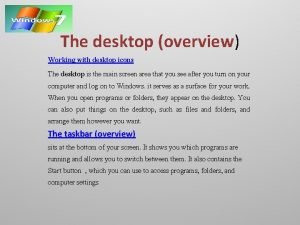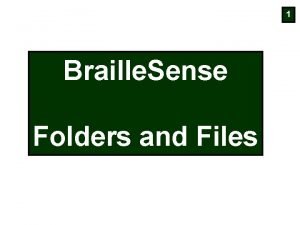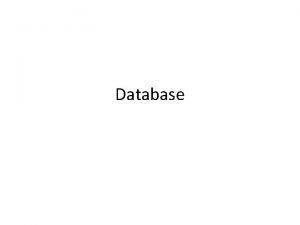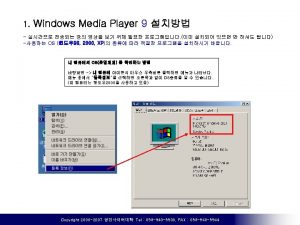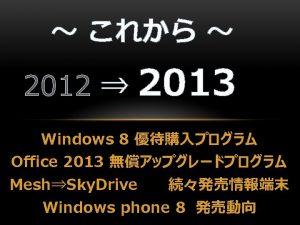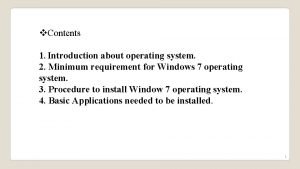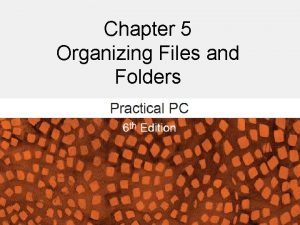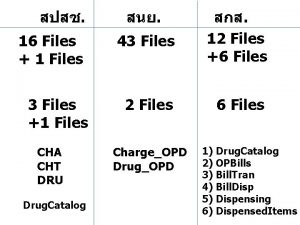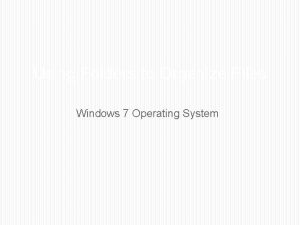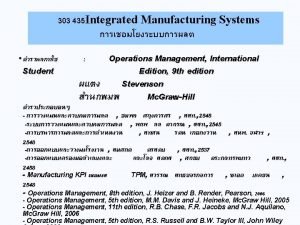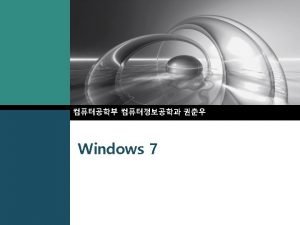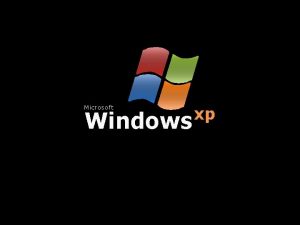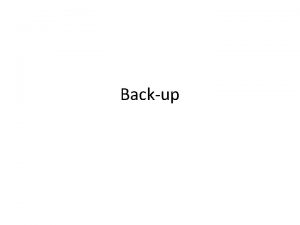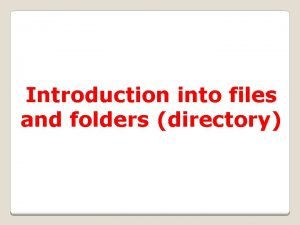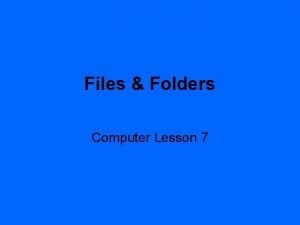FILES FOLDERS FINDING ORGANIZING YOUR FILES IN WINDOWS
































- Slides: 32

FILES & FOLDERS FINDING & ORGANIZING YOUR FILES IN WINDOWS

Files & Folders DEFINITIONS

DEFINITION OF “FILE” • A file is an object on a computer that stores data, information, settings, or commands that are used with a computer program. www. computerhope. com/jargon/f/file. htm • A file, in the computer world, is a self contained piece of information available to the operating system and any number of individual programs. Information inside the file could consist of essentially anything but whatever the file contains is likely related somehow. A computer file can be thought of much like a traditional file that one would find in an office's file cabinet. pcsupport. about. com/od/termsf/g/file-definition. htm • A computer file is a resource for storing information, which is available to a computer program and is usually based on some kind of durable storage. A file is "durable" in the sense that it remains available for other programs to use after the program that created it has finished executing. Computer files can be considered as the modern counterpart of paper documents which traditionally are kept in office and library files, and this is the source of the term. en. wikipedia. org/wiki/Computer_file

TYPES OF “FILE” • Program files: files used to make the computer work; e. g. : • system files (used by the Windows operating system) • application files, used by individual application, such as mail & calendar application; MS Word, Excel, Power. Point; etc. . • Data files: files storing information required by the user; e. g. : • documents, photos, videos, music, etc. . • Data files used/produced by programs to convey information to the user; e. g. : • log files (e. g. list of backed-up files); • history files (e. g. list of websites visited); • some ‘settings’ files for program customisation; etc. .

DEFINITION OF “FOLDER” • A folder is a virtual location where programs, files, and other folders can be located. www. computerhope. com/jargon/f/folder. htm • A virtual container within a digital file system, in which groups of files and other folders can be kept and organized. en. wikipedia. org/wiki/Folder • A digital folder has the same purpose as a physical folder – to store documents. Computer folders can also store other types of files, such as applications, archives, scripts, and libraries. Folders can even store other folders, which may contain additional files and folders. techterms. com/definition/folder Folders are designed for organizing files. For example, you might store your digital photos in a "Pictures" folder, your audio files in a "Music" folder, and your word processing documents in a "Documents" folder. In Windows, software programs are installed by default in the "Program Files" folder, while in OS X they are stored in the "Applications" folder. techterms. com/definition/folder

FOLDERS ARE ‘VIRTUAL’ • A folder is a virtual location where programs, files, and other folders can be located. www. computerhope. com/jargon/f/folder. htm • While folders may contain several gigabytes of data, folders themselves do not take up any disk space. This is because folders are simply pointers that define the location of files within the file system. techterms. com/definition/folder • This means that, when you move a file from one folder to another folder (on the same disk drive) – even if it is a large file – the ‘move’ is instantaneous because the file is not physically moved from one part of the disk to another: the computer merely updates its internal ‘index’ as to which folder it belongs to. • So if you want to ‘relocate’ a file, always move it: if you copy it and then delete the original, it has to read & re-write the entire file.

Files & Folders DIRECTORIES & THEIR STRUCTURE

DIRECTORIES • ‘Directory’ is the generic term for what Windows calls a ‘folder’. • Other computing systems have, for examples, referred to ‘directories’ as ‘catalogs’ or ‘drawers’. • The terms ‘directory’ and ‘folder’ may be used interchangeably. Screenshot of a Windows command prompt window showing a directory listing.

DIRECTORY STRUCTURE • The arrangement of directories is referred to as a ‘Directory Structure’. • Each physical computer disk/drive will (can) have its own ‘Directory Structure’: • specifically: • the/each ‘hard disk/drive’ within the computer; • any separate hard drive(s); • any network drives, e. g. other computers connected to the same work/home network; • but also any DVD/CD disk, or USB drive, etc. (although here, sub-directories may not be used). • Additionally, a single computer ‘hard drive’ can be partitioned into two or more effectively separate hard drives, each of which will then have its own directory structure.

DIRECTORY / DRIVE LETTERS Each computer disk/drive is identified by an alphabetic letter. • Normally, the main hard disk/drive within a computer is identified as the “C: / drive”. This is because early personal computers did not have hard drives, but used two ‘floppy disks’: one for the system & programs, and one for data. These were referred to as the ‘A’ & ‘B’ drives. Hence, when hard drives were introduced, they became the ‘C’ drive. • Additional drives (permanent or removable) take subsequent letters in turn, but can be allocated specific letters by choice.

DIRECTORY STRUCTURE • Every ‘Directory Structure’ is hierarchical, with a single top-level ‘Root directory’ (or ‘folder’) • Each physical computer disk/drive will have its own ‘Directory Structure’ (even if that structure contains no more than the Root directory, with files in it).

DIRECTORY STRUCTURE “Root directory/folder” identified by “/” (backslash) and (optionally) by drive letter, e. g. “C: /” Every directory/folder can optionally contain: • any number of sub-folders; and/or • any number of files; or • be “empty”. For all practical purposes, there is no limit to the number of: • hierarchical levels, or • files & sub-folders per folder. (Diagrams show only sub-folders, not files. )

FURTHER TERMINOLOGY • Root directory • Home directory (per user) each with own choice of sub-directories • Sub-directory • Parent / child directories In all cases, “folder” may be substituted for “directory” (Diagrams show only sub-folders, not files. )

Files & Folders VIEWING DIRECTORIES IN WINDOWS

WINDOWS DISPLAYS … … the hierarchical structure rotated through 90° anticlockwise, such that: • the hierarchical levels run left to right rather than top to bottom, and • each level is shown vertically rather than horizontally. It then compacts it further …

Level 5 Level 4 Level 3 Level 2 Level 1 Root … to give a diagram like this …

Windows Explorer In Windows, the directory structure, folders, and files are ‘explored’ using Windows Explorer (in Windows 10, this has been re-named and re-vamped as File Explorer) The design and appearance of Windows Explorer has changed over time, but in all versions: • There are two panels: • the left panel shows the directory structure, and • the right panel shows the contents of the folder currently selected in the left panel • In the left panel, you can expand / collapse any individual folder to display hide its sub-folders (child folders).

In earlier versions of Windows Explorer … … the directory structure in the left panel: • was clearly shown by connecting lines; with • ‘plus’ and ‘minus’ signs indicated which levels were shown collapsed (‘plus’ sign) or expanded (‘minus’ sign); and • you could click on the ‘plus’ or ‘minus’ sign to expand / collapse any individual folder.

Later versions of Windows Explorer … … omitted the by connecting lines (arguably making the folder connections a little more difficult to read), but the ‘plus’ / ‘minus’ signs for indicating and expanding / collapsing the sub-folders were retained. Any folder without a ‘plus’ / ‘minus’ sign has no sub-folders.

In Windows 7 … … the ‘plus’ / ‘minus’ signs have been replaced by clickable hollow / filled arrowheads Any folder without an arrow-head has no sub -folders.

In Windows 10 … … the clickable arrow-heads have become clickable ‘V’-shapes: • grey & right-pointing indicating a collapsed folder; and • black & down-pointing indicating an expanded folder. Any folder without an arrow-head has no sub-folders. BUT … to add to the confusion, the ‘V’-shapes disappear completely if the panel loses focus!

Files & Folders FILES

RECAP Definition of “File” • A file is an object on a computer that stores data, information, settings, or commands that are used with a computer program. www. computerhope. com/jargon/f/file. htm Types of “File” • Program files: files used to make the computer work • Data files: files storing information required by the user; e. g. : • documents, photos, videos, music, etc. . • Data files used/produced by programs to convey information to the user; e. g. log files, history files, settings files.

FILE NAMES A Windows file name is always in two parts, separated by a dot: This is the file name. ext name • For a normal data file, this can be any descriptive name of your choosing (within certain limits) extension • Specifies the type of information and coding used within the file. • Choose a meaningful & descriptive name. • Indicates the program to be used to read / open the file, as specified in the list of ‘default programs/apps’ in Windows settings. • continued … • Usually 3 -4 characters in length • May not be displayed in Windows File Explorer, according to Settings.

FILE & FOLDER NAME RESTRICTIONS This is the file name. ext • Never change the filename extension! • A file or folder name (in Windows) can: • include any standard characters except: / ? : * " < > | • include ‘space’ characters • include upper & lower case characters • be up to 255 characters in length, but the entire file path name must not be more than 260 characters in length • A file name (in Windows) can: • include additional ‘dots’, but the last dot will always be treated as a separator preceding the filename extension.

FILE PATH NAME The file path name is the file name preceded by: • the Root folder name, and • the full ‘list’ of folders & sub-folder names between the file & the root Hence the full path for the bluehighlighted filename on the far right is as set out below (71 characters long) Note the forward slashes separating each component of the full path name. Also note that the full path is given at the top of File Explorer (highlighted yellow) E: /_Ex-Glite DATA (D)/BOOKS, ETC/Helpful Books/Top Tips for Tablets. pdf

FILE PROPERTIES As well as its name, a number of ‘properties’ are stored in relation to each file: • Name, Type, Size, Date & time created, Date & time (last) modified, various ‘Attributes’ • plus almost 300 other optional properties depending on file type These can all be displayed in columns in Windows File Explorer, and you can sort by any chosen column in order to help you find particular file(s)

DEFAULT FILE LOCATIONS • One of the top-level folders within the C: drive (named as ‘System (C: )’ in Windows 7; and as ‘Windows (C: )’ in Windows 10) is a folder called ‘Users’. • Within the Users folder are sub-folders: • for each User Login Name • for ‘Public’ • These folders are the actual locations of the ‘default’ folders often referenced through the ‘Libraries’ • The ‘Libraries’ are actually ‘pointers’ to the corresponding folders for the currently logged-in User. • Any user with ‘Admin’ privileges should be able to access another User’s files through the respective user’s folders, even though the Library folders may still point only to the current user’s files.

HINTS FOR ORGANISING FILES - 1 • Create a folder structure that makes sense to you, with as many levels & sub-levels as required. • How would you have organised your documents, videos, photos, etc. when stored in hard copy? Is it appropriate to mimic that organisation in a directory structure? • Give files (and folders) meaningful names, which: • you will understand at a future date; • which will sensibly sort alphabetically within a folder; • are consistent. • If you might want to identify/sort files by date, consider whether the ‘file created’ & ‘file modified’ dates are sufficient. If not consider including the date as part of the file name: for sorting, include it at the front of the file name in ISO (year first) sequence, including zeros as appropriate to achieve correct sorting; e. g. 2016 -03 -04.

HINTS FOR ORGANISING FILES - 2 • You do not have to keep all documents under a top-level called ‘Documents’. • Likewise, you do not have to keep all downloads, music, pictures, videos, etc. under corresponding top-level names: use a structure that makes sense to you. • Move downloaded files into appropriate subject areas within your personal directory structure, instead of keeping them under ‘Downloads’. • Mix documents, pictures, etc. all within a single folder if they all relate to the same subject. • Use your own directory structure - not Microsoft’s! • Possibly use a few high-level folders for appropriate broad subject groupings, rather that a long list of lots of lower-level groupings.

HINTS FOR FINDING FILES • Keep them in a folder structure that makes sense to you – and know your way around it! • If you know which folder(s) to look in, use Windows File Explorer to sort the contents of each folder by file name, date, file type, or whatever property is appropriate. • If you know part of the filename, use ‘Find / Search’ within Windows File Explorer to search for an appropriate word, starting at the highest appropriate directory level. • If the file is sufficiently recent to be included in a ‘Recent files’ list in programs such as MS Word or Excel, look there.

ANY QUESTIONS ?
 A small picture that represents a folder or program
A small picture that represents a folder or program Dot powai files are binary files
Dot powai files are binary files Cjis security levels
Cjis security levels Cjis meaning
Cjis meaning Folders qcom
Folders qcom Braille folders
Braille folders Traditionally, composed of a collection of file folders.
Traditionally, composed of a collection of file folders. Dienst wonen gent
Dienst wonen gent Folders aksioma
Folders aksioma Google drive stream
Google drive stream Career portfolio examples
Career portfolio examples Organizing and outlining your speech
Organizing and outlining your speech Strategic organization speech
Strategic organization speech Amtobul example
Amtobul example Organizing an argument
Organizing an argument Organizing your argument
Organizing your argument Movie maker live
Movie maker live Windows media player 9 for windows 10
Windows media player 9 for windows 10 Windows live mail xp
Windows live mail xp Windows driver kit windows 7
Windows driver kit windows 7 Windows movie maker download microsoft
Windows movie maker download microsoft Windows media player skins
Windows media player skins Windows identity foundation windows 10
Windows identity foundation windows 10 Upgrade windows 7 to windows 10
Upgrade windows 7 to windows 10 Install windows xp virtual machine
Install windows xp virtual machine Nokia lumia 920 windows 10
Nokia lumia 920 windows 10 Window movie maker 2012
Window movie maker 2012 Ipseq
Ipseq Windows xp mode for windows 10
Windows xp mode for windows 10 Innovation sweet spot
Innovation sweet spot Finding your focus
Finding your focus Give us your hungry your tired your poor
Give us your hungry your tired your poor Windows is finalizing your settings
Windows is finalizing your settings
